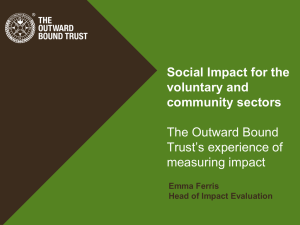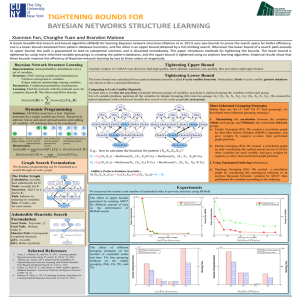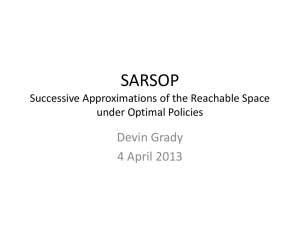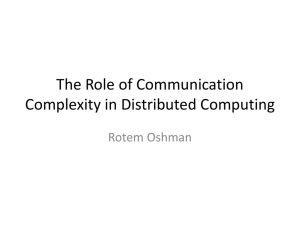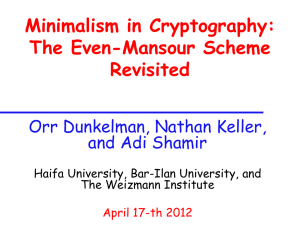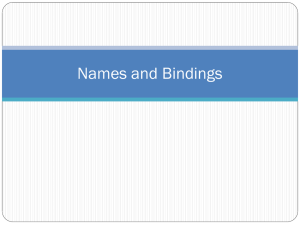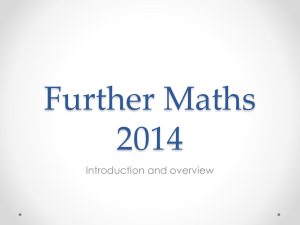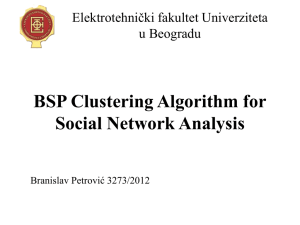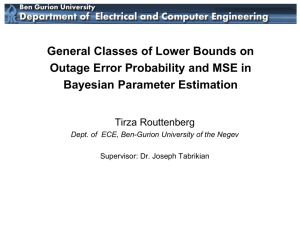PrologThinking
advertisement
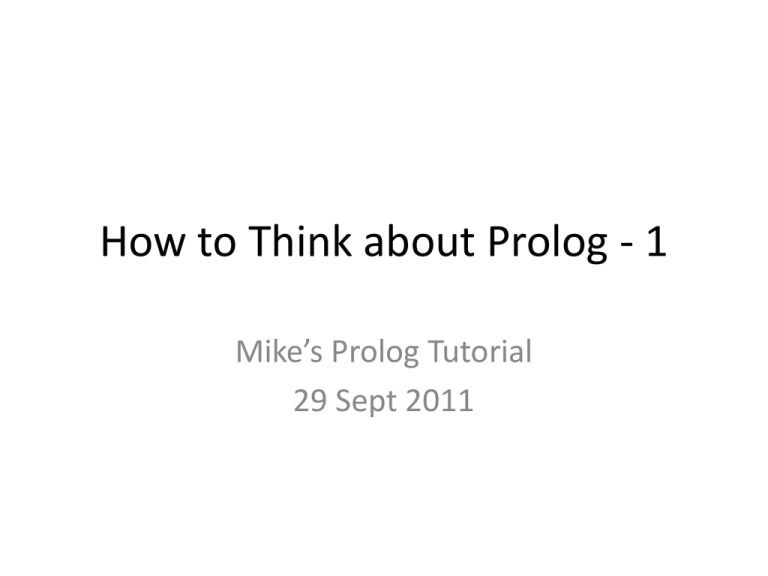
How to Think about Prolog - 1 Mike’s Prolog Tutorial 29 Sept 2011 Ideal Evolution of Prolog Programs 1. View the problem as a relationship between “things” 2. Find simple examples of that relationship 3. Define the relationship in English 4. Translate it into FOL 5. Devise representation of “things” where relationship becomes “definable” 6. Translate that into a correct Prolog program 7. Arrange clauses/preds so program terminates 8. Arrange clauses/preds so program efficient Evolution Never Ideal • Real development never goes this directly • Then why talk about the ideal? • Because when things go wrong, you can use it to diagnose which stage to go to. Example Problem • Rush Hour domain • Forward search (at least for IDA*) is too inefficient • Would like to do bidirectional search • Need fully specified goal state but only have partially specified goal state • Want to create the set of possible fully specified goal end states Step 1: See problem as relationship • View the problem as a relationship between “things”, what relationship? Step 1: See problem as relationship • View the problem as a relationship between “things”, what relationship? • Informally, in English, we want states that : – Satisfy the goal – Are reachable from the initial state Step 1: See problem as relationship • View the problem as a relationship between “things”, what things? Step 1: See problem as relationship • View the problem as a relationship between “things”, what things? – Fully specified goal state – Given partially specified goal state Step 1: See problem as relationship • View the problem as a relationship between “things”, what things? – Fully specified goal state – Given partially specified goal state – Initial state – Rules of Rush Hour • Initial state and rules of Rush Hour define reachability for us • Rush Hour rules are only implicitly defined Step 2: Find examples • Find simple examples of that relationship Step 3: Define relationship in English • fullySpecifiedGoalState(InitialState, PartiallySpecifiedGoalState, FullySpecifiedGoalState) :• FullySpecifiedGoalState satisfies PartiallySpecifiedGoalState • FullySpecifiedGoalState reachable from InitialState Step 3: Define relationship in English • FullySpecifiedGoalState satisfies PartiallySpecifiedGoalState means that the red car is in its exit location • FullySpecifiedGoalState reachable from InitialState means there is some sequence of “actions” that transforms InitialState into FullySpecifiedGoalState Step 4: Translate it into FOL • fullySpecifiedGoalState(InitialState, PartiallySpecifiedGoalState, FullySpecifiedGoalState) :– FullySpecifiedGoalState |= PartiallySpecifiedGoalState – exists(<a0, a1, ..., an>) | • an(...(a1(a0(InitialState))...) = FullySpecifiedGoalState An obstacle • reachable looks like it will be very expensive to compute and we would have to solve our problem (many times over) to compute it • if exact relationship is too expensive to compute then what can we do?? Next best • If the exact answer is too expensive then use approximations. • What does that mean in this situation? Next best • If the exact answer is too expensive then use approximations. • What does that mean in this situation? – Upper bounds – Lower bounds • What does that mean? Next best • If the exact answer is too expensive then use approximations. • What does that mean in this situation? – Upper bounds • Every state in the exact solution is also a state in the approximation – Lower bounds • Every state in the approximation is also in the exact solution Upper & Lower Bounds • Note that the set of all states is an upper bound for our problem and that the empty set is a lower bound. • Obviously not all bounds are equally useful. • The closer the bound is to the exact solution the better and the cheaper the computation of that approximation the better. • There is a tradeoff between cost and fineness of approximation. Which type of bound do we want? • What we want is the set of all reachable states that satisfy the goal condition so that we can use it to search backwards. • What is the worst case if we use a lower bound? • What is the worst case if we use an upper bound? Which type of bound do we want? • What we want is the set of all reachable states that satisfy the goal condition so that we can use it to search backwards. • What is the worst case if we use a lower bound? – Incompleteness • What is the worst case if we use an upper bound? – Too costly Which type of bound do we want? • We want an upper bound – But we want one that is small and cheap to compute • How do we do this? Which type of bound do we want? • We want an upper bound – But we want one that is small and cheap to compute • How do we do this? – Given our initial state and our rules, we try to find invariants, i.e., conditions that are true in our initial state which are preserved by our rules. – Why???? Invariants => Upper Bounds • We use the invariant as a filter. • If we know all states reachable from I satisfy some condition then we can filter out all those states that don’t satisfy that condition. – The most obvious of these conditions are invariants. Hunting for invariants • What is in our initial state that is preserved by the actions? Hunting for invariants • What is in our initial state that is preserved by the actions? – All vehicles on board – No two vehicles in same location – Vehicles cannot change orientation – Horizontal vehicles cannot change row – Vertical vehicle cannot change column • These invariants can be viewed as constraints Modifying our defintion • fullySpecifiedGoalState(InitialState, PartiallySpecifiedGoalState, FullySpecifiedGoalState) :– FullySpecifiedGoalState |= PartiallySpecifiedGoalState – exists(<a0, a1, ..., an>) | • an(...(a1(a0(InitialState))...) = FullySpecifiedGoalState – satisfies(Constraints, FullySpecifiedGoalState) Refining Problem Type • Given: satisfies(Constraints, FullySpecifiedGoalState) it seems obvious that our problem is a constraint satisfaction problem. • This means we should use our knowledge of CSPs to help formulate this problem. • This is where we will start next time.

